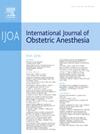Arterial bleed from an epidural puncture site: a case report
IF 2.6
3区 医学
Q2 ANESTHESIOLOGY
引用次数: 0
Abstract
This case highlights a rare complication of superficial arterial bleeding from an epidural puncture site.
A 27-year-old primigravida was admitted for induction of labour at 38 weeks' gestation due to obstetric cholestasis. An epidural for labour analgesia was inserted at spinal level L4-L5 with a 16G Tuohy needle. Blood-stained fluid was noted on aspiration, prompting its removal. Subsequently, there appeared to be arterial bleeding from the epidural site, which persisted despite prolonged pressure with epinephrine and tranexamic acid soaked swabs. The bleeding was ultimately controlled using a purse-string suture and subcutaneous epinephrine 20 μg on each side of the bleeding site, with a total estimated blood loss of 500 mL. There were no neurological concerns and no cardiovascular changes or evidence of formation of a superficial haematoma following the interventions.
Epidural related arterial bleeding is exceptionally rare and the primary concern is the risk of an epidural haematoma, especially if the source of the bleeding is unknown. There are only four case reports in the literature detailing superficial arterial bleeding following an epidural with differing management strategies including a purse-string suture or varying doses of subcutaneous epinephrine (30 μg−300 μg). Both techniques carry potential risks. In this case, a combination of a purse-string suture and low-dose subcutaneous epinephrine effectively controlled the bleeding, with no complications. We recommend using the lowest effective dose of subcutaneous epinephrine with vigilant maternal and fetal monitoring. Any lower limb neurological changes warrants urgent imaging and a neurosurgical evaluation to exclude an epidural haematoma.
求助全文
约1分钟内获得全文
求助全文
来源期刊
CiteScore
4.70
自引率
7.10%
发文量
285
审稿时长
58 days
期刊介绍:
The International Journal of Obstetric Anesthesia is the only journal publishing original articles devoted exclusively to obstetric anesthesia and bringing together all three of its principal components; anesthesia care for operative delivery and the perioperative period, pain relief in labour and care of the critically ill obstetric patient.
• Original research (both clinical and laboratory), short reports and case reports will be considered.
• The journal also publishes invited review articles and debates on topical and controversial subjects in the area of obstetric anesthesia.
• Articles on related topics such as perinatal physiology and pharmacology and all subjects of importance to obstetric anaesthetists/anesthesiologists are also welcome.
The journal is peer-reviewed by international experts. Scholarship is stressed to include the focus on discovery, application of knowledge across fields, and informing the medical community. Through the peer-review process, we hope to attest to the quality of scholarships and guide the Journal to extend and transform knowledge in this important and expanding area.

 求助内容:
求助内容: 应助结果提醒方式:
应助结果提醒方式:


